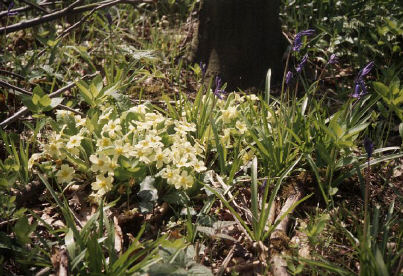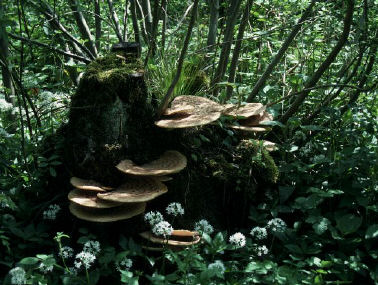
 |
WELCOME TO CHESHIRE BIODIVERSITY
|
|
| HOME | INTRODUCTION | SPECIES | HABITATS | PARTNERS | WHAT'S NEW | WHAT'S ON | OTHER INFO |
Bluebell, Dormouse, Stag beetle
What is an Ancient Semi-Natural Woodland?
Ancient semi-natural
woodlands (ASNWs) are woods that have persisted in the landscape since the Middle
Ages, from a date of approximately 1600AD and continuity of a woodland on a
site since around this date determines whether it is classed as ancient.
Some ASNWs may have been felled several times, so species composition and the
size of the trees present does not necessarily prove a site to be ancient. In
fact some ASNWs may have been replanted with plantations of conifers and may
not initially appear to be ancient woodland areas.
The date 1600 is taken as an indicator because it marks the time when map evidence
began to become more widespread and also when the planting of new woodlands
occured more frequently.
Why are Ancient Semi-Natural Woodlands important?
ASNW is an important part of our natural heritage, as such areas usually contain a diverse array of animal and plant species, many of which are unique to such sites and which also represent the remaining link to the original 'wildwoods', which once covered most of England. Consequently the variety of woodland structure may be diverse and might incorporate pockets of species rich heathland, grassland and marsh within the overall area of woodland.
How is Ancient Semi-Natural Woodland identified?
There are several ways of determining whether a woodland is likely to be ancient and these include the following:
The name - wood", "dingle", "coppice" and "clough" are some of the key names to look out for.
Map features - Irregular boundaries, sites on parish boundaries or along steep slopes and narrow river tributaries are also good indicators that a wood may be ancient.
Plant species - There are a number of plant species that can indicate whether a site may be ASNW. Some plants are better indicators than others and the more there are in any one wood, the more likely it is to be ancient.
Existing information - Current information, such as the English Nature ancient woodland inventory can be used to identify ASNW sites.
What is the extent of Ancient Semi-Natural Woodland in the Cheshire region?
The Cheshire region has only 4% woodland cover, which includes both ancient and secondary woodland (woodland planted after 1600). This figure is less than half the national average for a typical county. Of the woodland that is present, less than 1% comprises of ASNW.Circa 1920 there was 1,789ha of ancient woodland in the Cheshire region, 424ha of this being plantation (NCC 1988). By 1997 there was 1,681ha of ancient woodland in the Cheshire region, 1,263ha being ancient semi-natural woodland. 102ha has been cleared since c1920 (English Nature 1997). Most sites are less than 10ha and 65% are less than 5ha (NCC 1988).
Lack of knowedge and awareness
Planning and Policy.
Direct Action.
Survey and data gathering
Partners and Liaison
OBJECTIVES |
LOCAL TARGETS |
| To identify all ancient semi-natural woodland sites, of whatever size, in the Cheshire region. | Secure support and funding to extend ASNW survey to woodlands less than 2ha. |
| Plot all survey data onto GIS by 2006 to show current extent of identified ancient semi-natural woodland habitat. | |
| To protect all ancient semi-natural woodlands in the Cheshire region. | Maintain current extent of 1,263 ha of ancient semi-natural woodland. |
| Get all local authorities to include a policy of no further loss to development of ancient semi-natural woodland in the next revision of their local, structure or development plan. | |
| To extend and link fragmented ancient semi-natural woodland habitat with new native broadleaved woodland in the Cheshire region. | Establish 50 ha of new native woodland habitat by 2005 to link and buffer existing areas of ancient semi-natural woodland, including Alvanley Copse, Bank Farm, Wheeldon Copse, Brereton Farm and Village Wood. |
| To restore degraded ancient woodland and plantations on ancient sites in the Cheshire region. | Restore 10 ha of plantations on ancient woodland sites to semi-natural character by 2008. |
| Bring an additional 10 ha of ancient semi-natural woodland into management plan by 2008. | |
| To promote education and awareness in order to encourage responsible attitudes towards conserving ancient and ancient semi-natural woodlands. | Produce information boards to raise awareness of conservation and management issues for ancient and ancient semi-natural woodlands during 2004-5. |
| Hold/support event to engage landowners in ancient woodland conservation, management and extension during 2005. |
 |
Planning and Policy
Direct Action
Survey and data gathering / dissemination.
Partners and Liaison
| 2004 Action Completed |
|
1997- 2003 Action Completed |
|
 |
Read the ‘Ancient
Woodlands in the Cheshire region’ leaflet
The Wirral Biodiversity Action Plan
for Woodlands can be seen at www.wirral.gov.uk/ed/biodiversity/wood.htm
UK BAP for Upland Oakwood - www.ukbap.org.uk/UKPlans.aspx?ID=1
UK BAP for Upland Mixed Ashwoods - www.ukbap.org.uk/UKPlans.aspx?ID=3
UK BAP for Wet Woodland - www.ukbap.org.uk/UKPlans.aspx?ID=4
Woodland Trust 5 year Ancient Tree Hunt - www.ancient-tree-hunt.org.uk
| LBAP Chair | Ian
Aldred, Cheshire County Council Phone 01244 603162 Fax 01244 603125 |
| National Lead Partners |
Forestry
Commission |
| National Contact | Gordon
Patterson, Forestry
Commission Phone: 01313 346464 Ruth Jenkins, Forestry Commission Wales |
| HOME | INTRODUCTION | SPECIES | HABITATS | PARTNERS | WHAT'S NEW | WHAT'S ON | OTHER INFO |
|